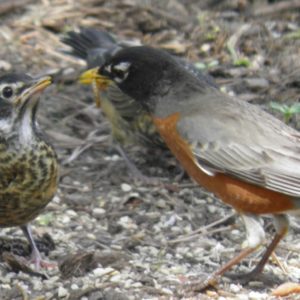Spring formally arrived March 20, 2017. The vernal equinox marks the beginning of spring. As the name implies, it is the moment of “equal night” in both hemispheres. The hours of light and dark are near equal. This happens twice a year, March and September. Signs of Spring start in Ohio even when we are still seeing signs of winter. The Robins arrive, the spring peepers sing their chorus, daffodils break through the frozen earth and yes, the baby animals are born.
formally arrived March 20, 2017. The vernal equinox marks the beginning of spring. As the name implies, it is the moment of “equal night” in both hemispheres. The hours of light and dark are near equal. This happens twice a year, March and September. Signs of Spring start in Ohio even when we are still seeing signs of winter. The Robins arrive, the spring peepers sing their chorus, daffodils break through the frozen earth and yes, the baby animals are born.
The cute critters that we associate with Easter and Spring arrive this time of year for a reason. Animals born in spring have the best chance of survival. Spring is the time of year when the weather begins to warm and food sources are plentiful. This breeding cycle has a lot to do with where in the world the animals live. For most mid latitude animals, ideally they are born in time enough to avoid a late snow storm and early enough to grow healthy and strong before Fall and Winter arrive, which in Ohio means Spring.
For farmers raising livestock in Ohio it can be a tricky balance. You want the animals to arrive in time to get to full weight at the market, but not so early that you’re warming your entire flock of lambs in your kitchen on a cold Spring night. For lambs and kids that arrive in April or May, this means having mating service between Thanksgiving and Christmas. Before the babies arrive, be sure to have warming boxes and plenty of blankets on hand, along with your vet’s phone number.
Poultry farmers and backyard growers have a bit more flexibility manipulating Spring’s weather when raising chicks. Brooding equipment sold today is compact, safe and reliable. You can easily keep hundreds of chicks safe, warm and dry in brooding boxes in your barn or garage. I don’t recommend brooding in your house because of dust and odor. Always purchase spring chicks from a reliable hatchery. A good dealer won ‘t ship day old birds until certain dates to ensure their best chance for survival.
‘t ship day old birds until certain dates to ensure their best chance for survival.
Wild birds also mate in Spring. Some birds have multiple broods per year so they begin to mate early each season to maximize the time they have to get their young ready to leave the nest before the next brood begins. Take for example the American Robin and the Eastern Bluebird, their peak breeding time takes place in April and July. For backyard birders, ensuring the parents and their brood have a water source and plenty of natural habitat to forage for food will make the perfect spot for the birds to return each year to raise their families.
Another often overlooked Springtime breeder is the amphibian! Yes, our spring peepers and salamanders trav el to vernal ponds and wetland areas to breed and have their young. The Northern spring peeper is a small dime-sized frog. Its birdlike peep can be heard near just about any creek, puddle or pond in Ohio during their early spring breeding season. Salamanders don’t make any audible noises, but they play a critical role in our ecosystem, eating their share of worms and insects. They both travel to wetland areas to have their young, then back to woodland areas for the rest of the season. We can do our part by watching for them on roadways on cool wet spring nights when they attempt their journeys, and trying to not disturb their breeding ponds until after their young have migrated away from the water.
el to vernal ponds and wetland areas to breed and have their young. The Northern spring peeper is a small dime-sized frog. Its birdlike peep can be heard near just about any creek, puddle or pond in Ohio during their early spring breeding season. Salamanders don’t make any audible noises, but they play a critical role in our ecosystem, eating their share of worms and insects. They both travel to wetland areas to have their young, then back to woodland areas for the rest of the season. We can do our part by watching for them on roadways on cool wet spring nights when they attempt their journeys, and trying to not disturb their breeding ponds until after their young have migrated away from the water.
So enjoy the signs of Spring, the flowers, the frogs, the birds and animals. And remember that our own fervor in Spring is rooted in these natural cycles of life. Get outside, breathe the fresh April air and touch the rich brown earth because –
April hath put a spirit of youth in everything. -William Shakespeare